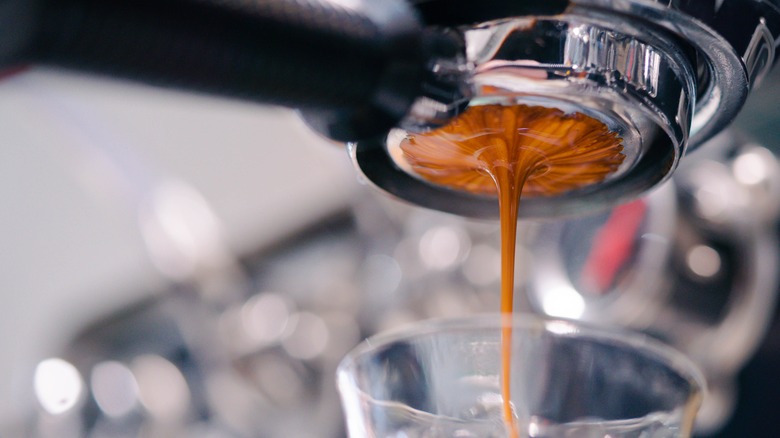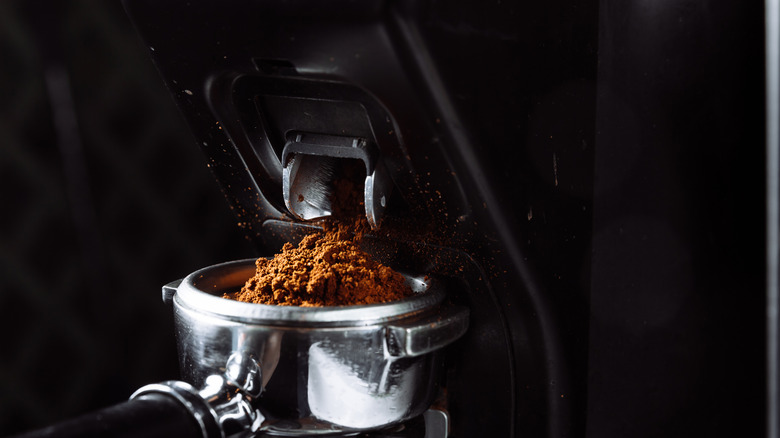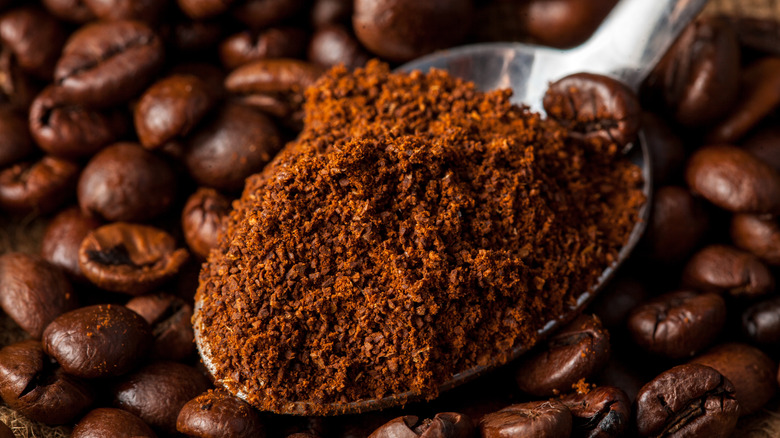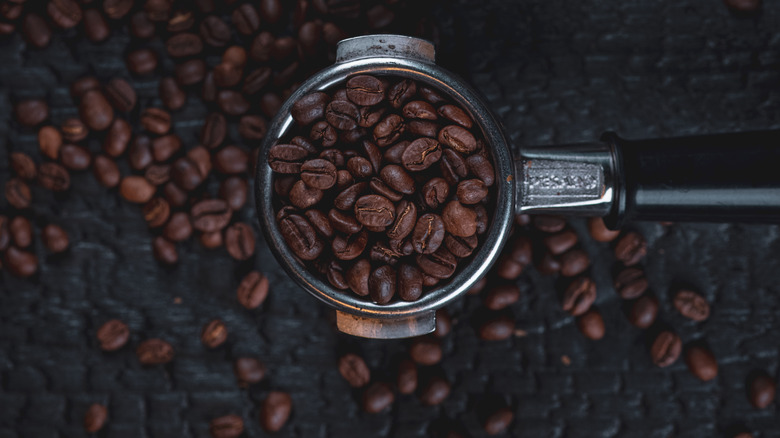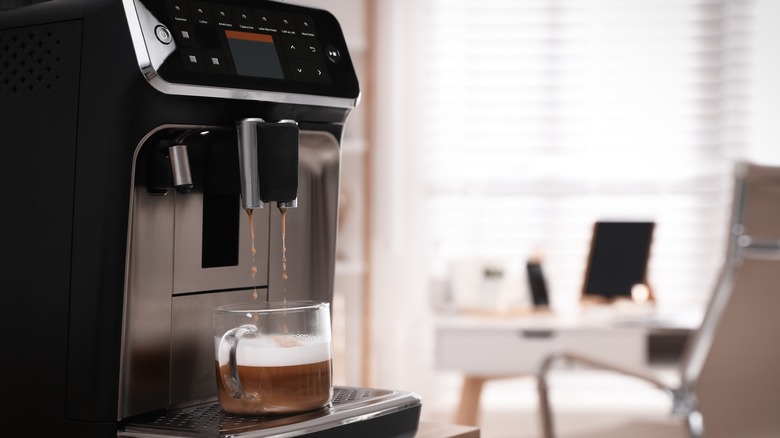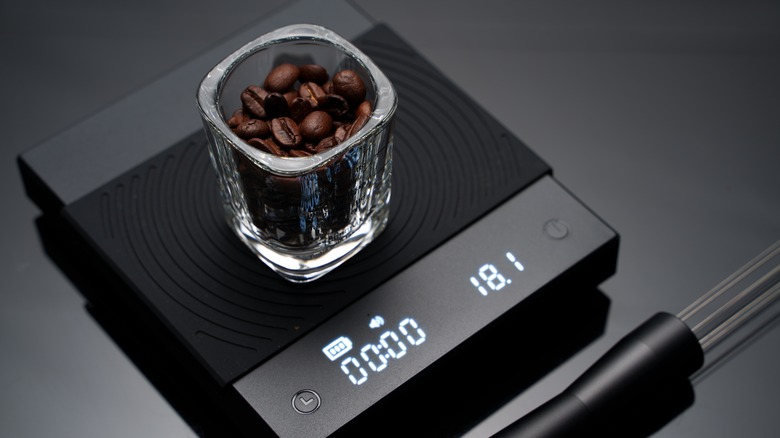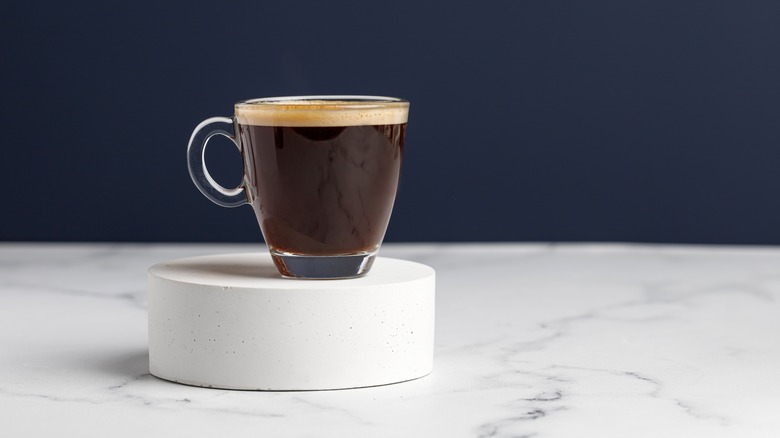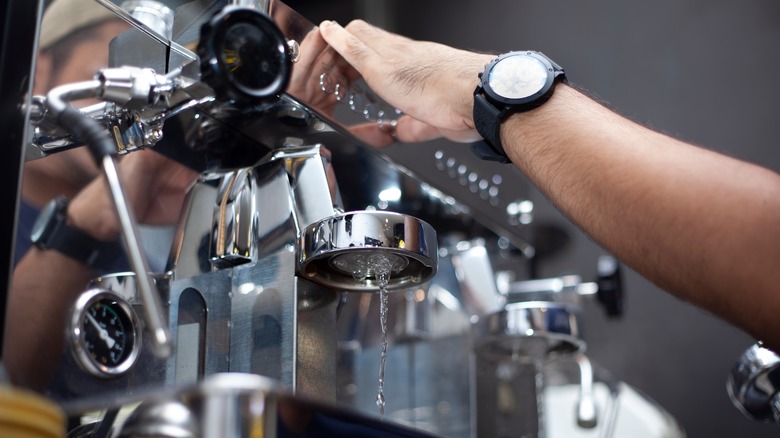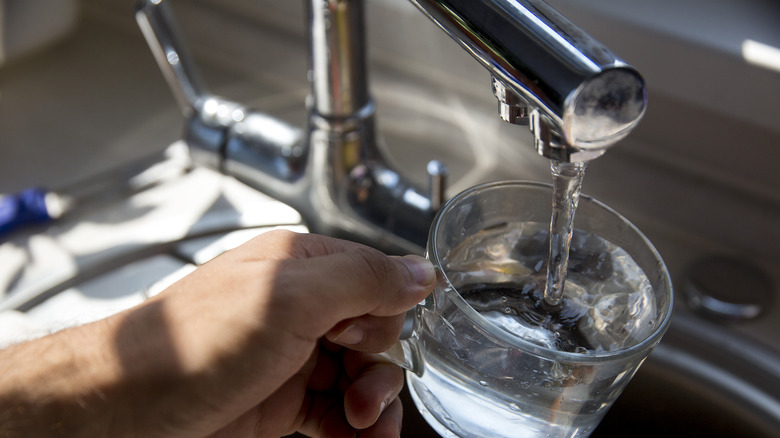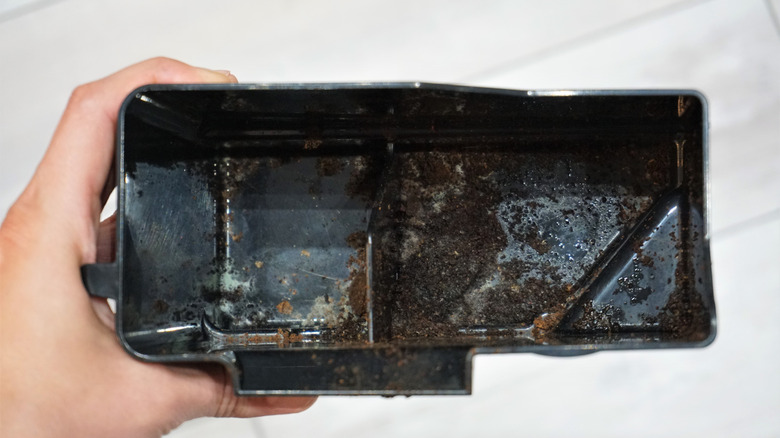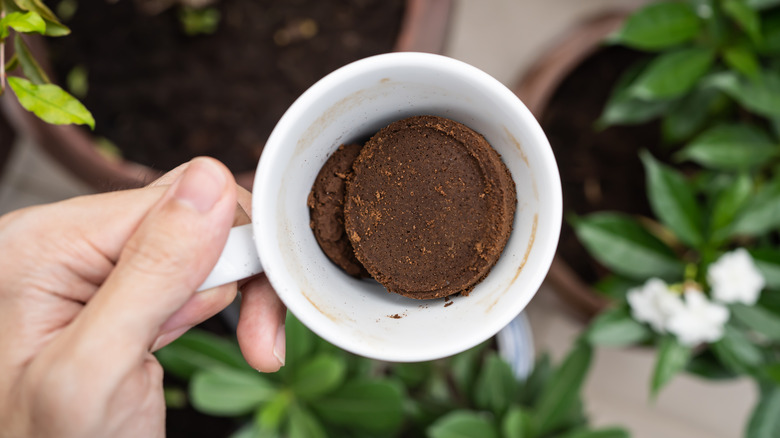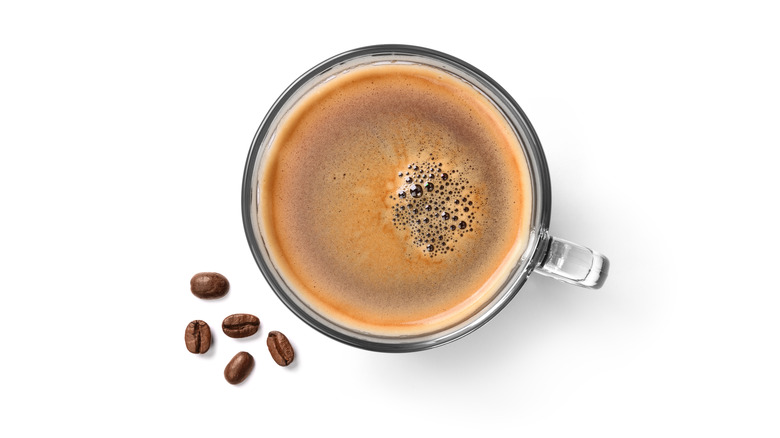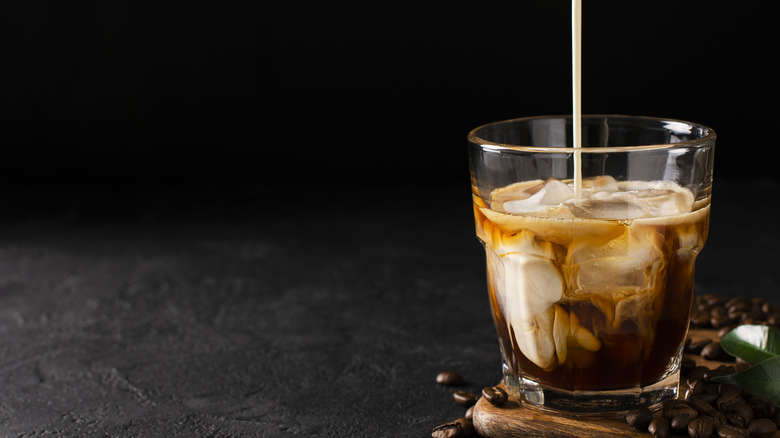13 Biggest Mistakes You're Making With Espresso At Home
We may receive a commission on purchases made from links.
It's hard not to be head-over-heels in love with espresso, especially if you're a self-proclaimed coffee snob. Unlike drip coffee, espresso is made with beans that have been roasted for longer the conventional coffee beans and ground much finer. The small grind size means that the water makes contact with the grounds for more time, thus infusing more flavor into the beverage. The espresso machine itself regulates the pressure and temperature of the water as its being pushed through the machine as well, which can give brewers a more specific and technical challenge when preparing espresso at home.
If you are perturbed by the amount you spend on espresso beverages — including lattes, cappuccinos, and Americanos — you might be inclined to try your shot at making espresso at home. It's important to remember, though, that making a good shot of espresso is like a craft — it needs to be practiced and honed over time. Here are some of the major mistakes most people make when diving into their DIY-espresso journey, as well as how to set yourself up for espresso success.
Not cleaning your grinder often enough
As with all kitchen appliances, you need to take care of your equipment to ensure it lasts you as long as possible. And if you neglect to properly care for your grinder, you may notice that your espresso tastes a little bit off. The structure of a grinder, which has a hopper as well as the burrs, can frequently get caked with grinds. If you neglect to clean your coffee grinder, these stale grinds can hang around and flavor each subsequent brew. The naturally oily beans can also cause issues in the consistency of the grind and lead to breakages in the machine.
To ensure a clean grind on your espresso, we recommend cleaning out your grinder every week or two. One tip to clean your grinder is first to remove all the coffee beans and add some rice to your machine. Run the grinder as normal to allow the rice to pulverize and soak up any oils or gunk left over from the coffee. Then, remove the rice from the machine and use a cloth to wipe up any remaining rice residue.
Using pre-ground coffee beans
If you're in a rush in the morning and scrambling to grind beans for your latte, you might ask yourself why you can't just buy pre-ground espresso coffee at the grocery store. We should first note that espresso refers to the grind size of the coffee, not exactly the type of bean itself. This means that the beans you buy for drip coffee or French presses are the same as your "fancy" espresso beans — it's just that the grind size is different.
Grinding your own beans is important for the flavor of the espresso because it increases the surface area, which in turn exposes the beans to air more quickly. If your ground espresso beans sit for too long, you can run into issues with your coffee going stale. This premise applies to regular, pre-ground coffee beans as well, which taste noticeably staler than their whole-bean counterparts.
Besides controlling the degradation of your coffee, grinding your own coffee allows you to create the perfect size grind for your machine. Espresso requires a much finer grind than drip coffee, so while you might be able to get away with a more coarse grind for a bean you plan to French press, a coarse bean size will result in a detrimental shot of espresso. If you plan to purchase espresso beans, you can buy the beans and grind only what you need.
Using beans that are too ripe or too old
The age of your beans is critical to crafting a good shot of espresso. Clive Coffee recommends using beans no earlier than five days after roasting. Waiting until the first week after roasting allows some of the carbon dioxide to degas from the beans; when the beans are placed in a pressurized environment, the carbon dioxide turns to carbonic acid — which results in an unpleasant, rancid taste.
On the flip side, using espresso beans that are too old can also create more issues for your brew. For the freshest possible brew, you should make the espresso within the first three weeks after roasting (via Espresso Works). There are many ways to tell if your espresso has gone rancid, too. The first major sign is a strange aroma that is mildewy or flat. When you go to brew the espresso, you'll find an absence of crema (the thin layer of bubbles on the top of the espresso) and a weak or sour taste. Coffee that has gone rancid will also emit more carbon dioxide — so try placing a handful of beans in an airtight plastic bag overnight. If the bag is puffy in the morning, your beans have likely gone stale.
Not starting with a simple machine
If you're in the market for an espresso machine, you might be inclined to purchase one with all of the bells and whistles attached to it. But if you get a machine that is too complex, you'll spend more time fooling around with the buttons, attachments, and machine than you will be getting a quality cup of espresso.
Espresso newbies should start with a simple or automatic machine before moving to something more technical — and not to mention expensive. One of our favorite models for espresso machines is the Wirsch Home Barista. It's priced at $199.99 at the time of publication and is only 5.5 inches wide, meaning it won't take up too much space on your countertop. The machine is easy to use and comes with a 2-in-1 option for double or single espresso shots, as well as a steaming wand for lattes and cappuccinos. If you're looking for a more technical machine, one of our top-ranking espresso machine brands is Breville, which offers several machines with built-in grinders for an all-in-one machine.
Not using a scale to measure your beans
Espresso is all about precision, so there's not much more precise than using a scale to measure out your beans beforehand. This is because a "scoop" of coffee is relative and can be different from brew to brew based on its grind size, variety, and roast. If something is going wrong in your brewing process, knowing how much coffee you added to the portafilter is essential in eliminating variables and finding the root of the problem.
There are numerous brands of specifically designed coffee scales on the market. The acacia scales can cost anywhere from $150 to $270 and can be used for both espresso and pour-over coffee. These scales track the flow rate on pour-over coffee and provide precise measurements with a quicker stabilizing time than other scales on the market. For folks on a budget, the Greater Goods Digital Coffee Scale offers all of the bells and whistles for a novice espresso maker — just $28.88.
Skipping a brew ratio
A brew ratio is a critical concept in the world of espresso. Flair Espresso notes that a brew ratio describes the relationship between the weight of grounds added to the filter versus the weight of coffee that comes out of the machine. Brewing a double shot of espresso, at what used to be considered a staple 60 milliliters, will taste different if you use 18 grams of espresso as opposed to 24 grams of espresso. Flair Espresso explains that both the grounds and the brew should be measured in weight rather than volume (such as milliliters) for precision and to consider the off-gassing that occurs with time.
There are three different types of brew ratios. A restricted shot has a 1-to-1.5 ratio of grinds to brew, while a typical espresso has 1-to-1.5 or 2.5. A long shot, also called a lungo, has 1-to-2.5 to upwards of 4. This means that a lungo brews more in weight than the other two types. If you want to have a restricted shot with more flavor over less water, you'll need to increase the pressure and shorten the brew time. All of these brew ratios are relative based on the flavor you want out of your espresso, but knowing about them can alter how you brew your espresso.
Not tamping down your espresso properly
"Tamping" is the term used for compressing the espresso granules into a puck in the portafilter. These tampers can come in a variety of materials and are fit to match the size of the filter you're using — so you'll never have to worry about the grounds going over the sides of the filter. The purpose of tamping is to add an additional pressurized environment for the water to flow through. You'll get more solubles (meaning more flavor) in your cup if your espresso is properly tamped. The perfect tamping provides even pressure across the puck — meaning that there are no spots with less pressure than others.
To tamp your espresso effectively, place the filter on a flat surface or use a portafilter holder to ensure the filter is level. Per Brew Espresso Coffee, you'll want to place about 30 pounds of pressure on the tamper with your thumb and index finger — meaning you should press on the base of the tamper rather than the handle. This will increase the pressure you can apply to the espresso. Avoid twisting the handle of the tamper as you press since this can create unevenness in the tamp.
Forgetting to purge some water before each shot
There's a lot that goes on behind the scenes of your espresso machine. A critical part of proper machine maintenance is purging water through your machines between shots. There are several reasons you should complete this simple practice, and it takes only a few seconds. The first is to remove any spent grinds between shots; this can easily cake up and cause poor flavor in subsequent espresso shots. When you remove the portafilter from the machine to pull out the puck, there is temperature instability as the unit is exposed to more air. Since the water that purges the machine is hot, it will keep this part of your espresso machine more stable between shots. Similarly, running hot water through the machine pushes out any cold water that may be in the lines between the water tank and the heating unit.
With a single-boiler espresso machine, running water through the lines can actually help cool the boiler in between shots. If too much water is left in the heating unit, it can cause the water that hits the espresso to be too hot, thus altering the flavor of the finished brew.
Using the wrong type of water
Water is a serious topic when it comes to espresso machines. And although it would be easier if it was, not all waters are created equal when it comes to espresso. You should use filtered water to make your espresso; the filter removes many of the dissolved solids in your water that can cause blockages in your machine and alter the flavor of your espresso.
Whole Latte Love notes that using reverse osmosis or distilled water is not ideal for espresso machines. While the filtration systems for these types of water remove both trace chemicals and dissolved solids from the water, these types of water are so pure that they can corrode your machine and cause significant damage. Distilled or reverse osmosis water can also leach more solids out of household water lines or the espresso machine itself, which defeats the purpose of the purifying process anyway.
Not cleaning your espresso machine often enough
Mold, mildew, and overall grossness — it's what happens to espresso machines that aren't cleaned often enough. The heat and moisture of the espresso machine are a breeding ground for bacteria and molds that can easily colonize and destroy your machine, not to mention potentially make you sick. It's important to regularly clean the spent ground receptacle of your machine, but you should also regularly descale the water lines of the machine to improve flow and keep your espresso tasting great shot after shot.
Using a 1-to-3 solution of water to vinegar can help aid in descaling your machine. Before descaling, consult your machine's manual to ensure that the acidity will not damage the machine. If the manual is unclear about cleaning instructions, simply reduce the amount of vinegar in the ratio. You can also use one teaspoon of citric acid dissolved in a cup of warm water to descale the water lines of your machine. Always be sure to run a flush of the machine after you've finished descaling to ensure your cleaning procedure does not impact the flavor of the final brew.
Leaving your grounds in the basket after making your espresso
You make an espresso, you have a million other things on your plate, and you leave the puck in the machine — we get it. But leaving your puck in your machine for too long is one of the biggest mistakes you can make when you're making espresso — especially when you don't regularly keep up with cleaning your machine.
One Home Barista user recommends cleaning the puck out of your machine every time to limit the oil and gunk that stays in your portafilter. Several users on the forum note the same, as well as how difficult it can be to dislodge a puck that has been stuck in the filter basket for too long. You should also take a couple of extra seconds to rinse and wipe your portafilter, group, and basket out with water and run a quick towel over the tools. This will prevent pesky espresso grounds from dropping into your espresso cup when you make your next shot.
Leaving the crema on your espresso
Crema is the thin layer of color on the top of your espresso. While this classy take on a milk mustache may be fun, the crema on your espresso may be contributing to a more pronounced bitter flavor than you'd expect. Crema is a mixture of fat and oils from coffee beans with a bit of carbon dioxide. The carbon dioxide, which forms carbonic acid under heat and high pressure, has especially bitter flavor notes.
Some sticklers prefer the crema and ultimately decide to leave it alone, while others tend to scoop it out of the beverage entirely. Removing the crema from your espresso may make it taste a little more balanced and flavorful. If you prefer the interesting and unique taste of the crema (or its golden brown hue), you can leave it in your espresso cup — and on your lips, too.
Not trying cold brew espresso
If you're a coffee snob that doesn't want to give up the powerful caffeinated punch of cold brew, you can try to make cold brew espresso. In a traditional cold brew extraction technique, the cold temperature of the water causes the flavors to extract more slowly and leaves behind less acidic flavors than a drip coffee (which can be chilled for a traditional ice coffee).
According to Perfect Daily Grind, you can create a synergy between the pressure extraction of an espresso machine and a cold extraction with a manual lever or hand-operated espresso press. You'll also need to add extra grounds to the portafilter and grind them finer than a traditional espresso. This will make up for the fact that you won't be using hot water to extract flavor. When you're ready to press, add cold water to the chamber and press the espresso down slightly, giving a couple of minutes for the espresso to drip out before pulling the shot. The website recommends using a 1-to-1 brew ratio for this espresso technique.
